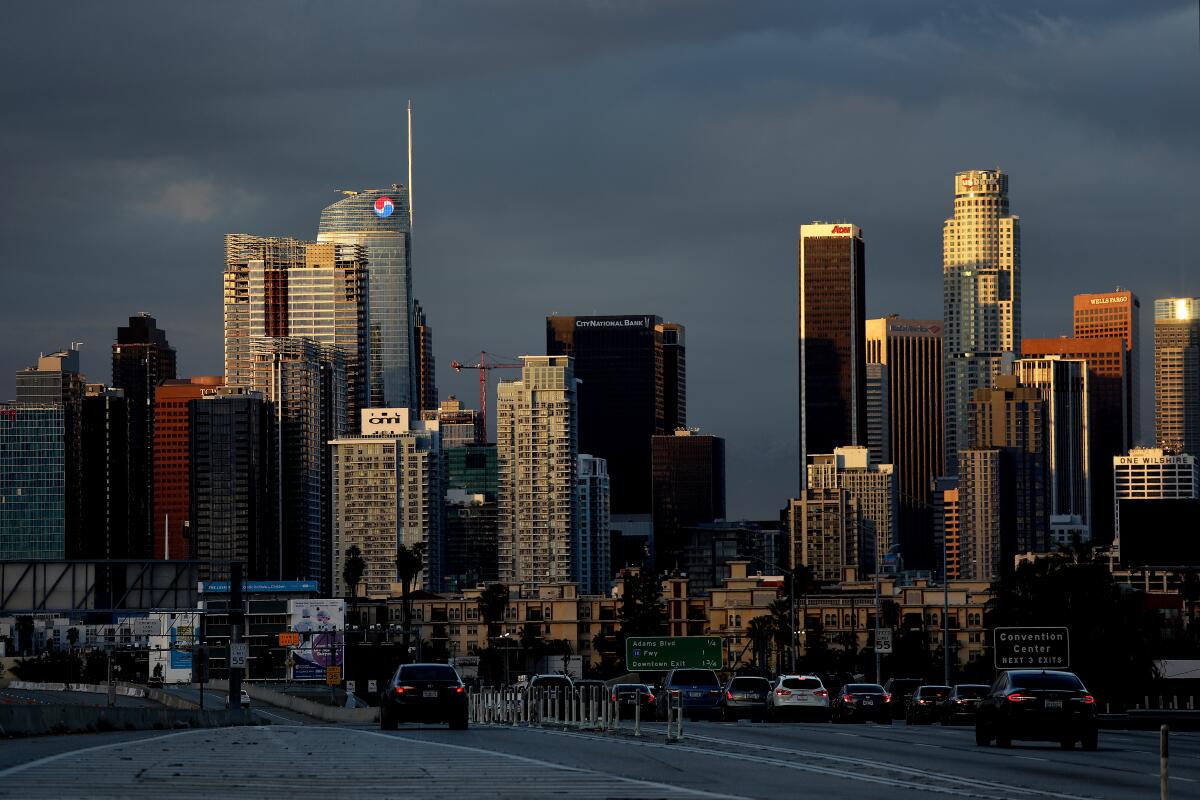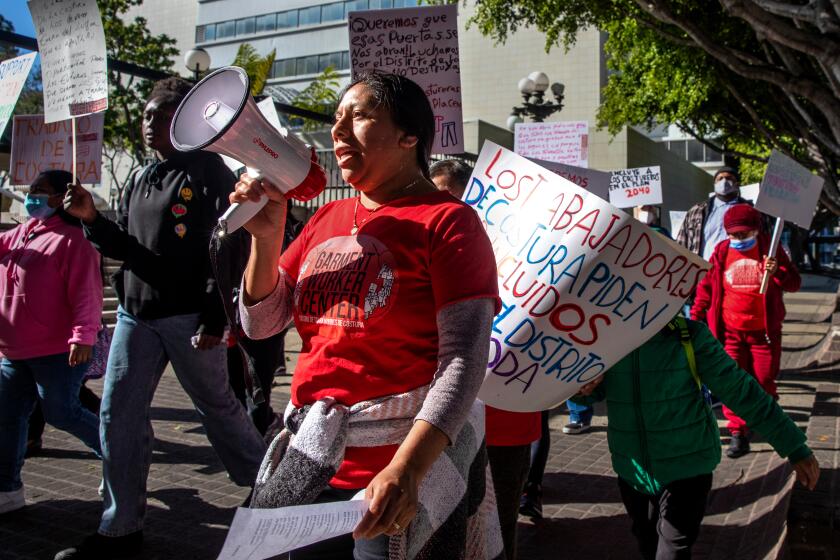L.A. adopts strategies for bringing 135,000 new homes to downtown and Hollywood

- Share via
The Los Angeles City Council approved two major zoning plans for downtown and Hollywood on Wednesday that, if successful, would bring as many as 135,000 new homes to those areas over the next 20 years.
The council, on a 13 to 0 vote, approved the DTLA 2040 plan, which seeks to attract 100,000 new housing units to an area stretching from the Convention Center east to the Arts District and north to Chinatown — more than a fifth of the estimated need citywide. In a second 13 to 0 vote, the council adopted the long-delayed update to the Hollywood Community Plan, which is supposed to create the capacity for 35,000 new units.
The city is required to regularly update each of its city’s 34 community plans, which map out where and how new apartments, office towers and other projects can be built. The council last updated its Hollywood plan roughly a decade ago, only to see that document struck down by a judge.
Council President Paul Krekorian said the downtown and Hollywood plans have been “undoubtedly the two most difficult” in the city.
“This is going to be incredibly important to the city’s economic development, its future and our housing — addressing our housing needs,” he said.
The DTLA 2040 plan would increase downtown’s housing supply by up to 100,000 housing units. Some workers fear that growth could come at the expense of their jobs.
Both planning documents, shaped in the wake of the COVID-19 pandemic, will offer new safeguards for staving off displacement, city officials said. Both feature new strategies for spurring the construction of affordable housing — apartment buildings where at least a portion of the units have rents below market rate. Those units would need to remain affordable for 99 years.
In Hollywood, developers of properties on some of the city’s busiest boulevards — such as Hollywood, Sunset and Cahuenga — will receive permission to build much larger buildings than otherwise allowed if they include a percentage of affordable units in their projects.
In downtown, the council approved an “inclusionary” housing system, requiring that newly constructed residential projects include at least a percentage of affordable units. In many instances, developers would be allowed to make their projects larger as long as they incorporate a greater number of affordable units, planning officials said.
The inclusionary requirements would not apply in cases where office buildings or manufacturing space are converted into housing.
The council also opened the door to residential development in a portion of skid row bounded by 5th Street on the north, 7th Street on the south, San Pedro Street on the west and Central Avenue on the east. However, in that area, developers would still need to construct projects that are at least 80% affordable — a threshold that’s much higher than in other parts of downtown.
Wednesday’s vote delivered a major victory to the Garment Worker Center, which had been fighting for new regulations to ensure sewing factories and other apparel-related businesses are not pushed out by new development. That group, which belonged to a coalition that included Unite Here Local 11, the politically powerful hotel workers’ union, won new restrictions on residential development and new hotels in parts of the Fashion District.
Business groups warned that those changes would render up to 12,000 residential units in the DTLA 2040 plan economically unfeasible, at least for the foreseeable future. That, in turn, will make it more difficult for downtown to reach its target of 100,000 new units, said Anthony Rodriguez, executive director of the Fashion District Business Improvement District.
“I’m just not sure how they’re going to go about finding developers that are interested in building new housing” in much of the Fashion District, he said.
The Garment Worker Center celebrated the council’s vote, calling DTLA 2040 a “reasonable compromise” that does not prioritize jobs over housing. “We clearly need both,” said Marissa Nuncio, the group’s director.
The council voted unanimously to study the plan’s impact on housing production in the Fashion District in the coming weeks. Councilmember Kevin de León hailed the new measures to protect manufacturing jobs, saying garment workers and hotel employees have been “holding on by a shoestring, not knowing if they’re going to be evicted from their homes.”
De León said downtown is doing more to address the housing crisis than any other part of the city, in part by establishing an inclusionary zoning system.
“We’re not just talking the talk about building inclusive communities, we’re actually walking the walk,” he said. “Because if we truly want to be a progressive city, we can’t just theorize or tweet about it. We actually have to do something about it that’s real and tangible.”
Councilmember Marqueece Harris-Dawson, who heads the council’s planning committee, also praised the plan’s focus on developing new apartments with restricted rent.
“Somebody somewhere down the line is going to move into an affordable unit downtown that would not have appeared if we had not done this work,” he said. “The market would not have produced that.”
Get the lowdown on L.A. politics
Sign up for our L.A. City Hall newsletter to get weekly insights, scoops and analysis.
You may occasionally receive promotional content from the Los Angeles Times.
Two of the council’s newest members — Eunisses Hernandez and Hugo Soto-Martinez — also put their stamp on the community plans. Hernandez reversed an effort by her predecessor, Councilmember Gil Cedillo, to get rid of height limits in a section of Chinatown. The council approved her request to retain a five-story height limit on stretches of Hill Street, Broadway and other nearby corridors.
Soto-Martinez, for his part, increased the affordable housing requirements included in a new incentive program targeting some of Hollywood’s busiest commercial districts.
Under the plan, housing developers in those areas would have the right to build 30,000 square feet of building for every 10,000 square feet of lot. If they meet the city’s new affordable housing requirements, they would receive permission to build 67,500 square feet of building for every 10,000 square feet of lot.
Those developers would need to set aside between 11% and 25% of their apartments for lower income households, depending on the affordability levels they select.
“This is just the beginning,” Soto-Martinez said. “There’s going to be so much work that’s going to happen in the coming years to make this city equitable, just and good for working people.”
More to Read
Sign up for Essential California
The most important California stories and recommendations in your inbox every morning.
You may occasionally receive promotional content from the Los Angeles Times.












